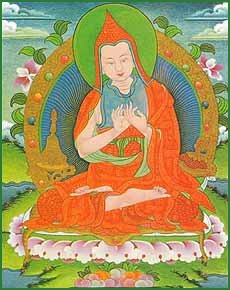The Great Chariot
by Longchenpa | 268,580 words
A Commentary on Great Perfection: The Nature of Mind, Easer of Weariness In Sanskrit the title is ‘Mahāsandhi-cittā-visranta-vṛtti-mahāratha-nāma’. In Tibetan ‘rDzogs pa chen po sems nyid ngal gso’i shing rta chen po shes bya ba ’...
Part 1b.1f - How consciousness dissolves
Here are the extensive divisions of the subject:
When we go to sleep at night, within the desire realm,
Awareness of the five objects by stages dissolves into mind.
Mind dissolves within the non-thought of alaya.
This is a one-pointed state without apparent objects.
That too dissolves in the nature, dharmadhatu, simplicity.When it develops again, from the alaya consciousness,
There is isolated mind, known as the mind of dreaming.
What is really nothing appears. We affirm and negate its variety.
This develops further, and we awake from sleep.
By entering into the objects and consciousness of the six senses,
Various karmic formations come to be engendered.
This is how things appear throughout the day and night.
When beings of the desire realm go to sleep, the awareness of the five gates of the senses and klesha mind gradually dissolve into the mental consciousness. As the mental consciousness dissolves into alayavijñana, luminous non-thought arises for a little while. Those who recognize this and rest within it course without dreaming in the luminosity of dharmata.
Though some teachers of the new transmission say the above, in fact alayavijñana dissolves entirely into the impermanent alaya. Alaya dissolves into dharmadhatu. On the subsiding of coarse and subtle grasping, the simplicity of empty and luminous dharmata arises. If it is recognized, confusion is eliminated.
Sangwa Yeshe (gsang ba ye shes) says in the Compendium of the Precious Tantras (rin po che’i rgyud kun ‘dus):
The seven collections dissolve in alaya consciousness.
After that, alaya is purified as space.
Then there is the primordial state of co-emergence,
The natural state of wisdom, emptiness/luminosity.
That is something that every yogin needs to know.
Then these unfold again: From dharmadhatu there is alaya, and from thatalaya consciousness, and from that, by the rising of the isolated mental consciousness, various dreams arise. At this time, objects of habitual patterns of mind are grasped as dharmas with their own indivi dual natures. Also the conceptually moved pranas and the pranas in the nadis that depend on the seven consciousnesses enter into the side nadis, roma and kyangma, and then the central channel. Then they are known as consciousness that is not equalized wi th alaya. That is because they are united with the nadis and pranas and equalized with them.
Then they enter into the central channel in one taste. This is the time of alaya. We go into deep sleep without dreams.
There are some who directly experience these characteristics of dreamlessness and rest there. Then as for alaya dissolving into dharmadhatu, in the center of the central channel, the nadi of supreme changeless luminosity, the coarse elements and pranas do not move. Alaya has that nadi’s nature of clear light.
The All- Illuminator (kun gsal) says:
The nadi that exists in the midst of the central channel
Is that of supreme changeless luminosity.
That clear and luminous space without solidity
Is self-existing wisdom, the true state of everything.
The essence of prana in the central channel is said to be awareness itself. At the time of prana’s entry there luminosity arises. At that time globes of shining light, radiance, rainbows, and so forth arise. Empty luminosity, mind itself free from all complexity arises. The luminosity of union, the great wisdom that experiences luminous insight, arises.
Then, when alaya, its consciousness and the mind consciousness unfold again, that is the time of proliferation of prana in the life nadi, which is the support of mind and memory. The mental prana that depends completely on memory proliferates. Then, as prana enters the nadis supporting the individual senses, we wake from sleep. The objects that appear by day arise in their usual unreflective grasping and fixation. Then if an object that seems to be form is conceptually apprehended, its individual divisions will really be nothingness.
